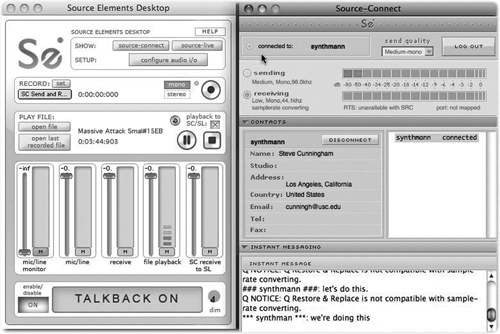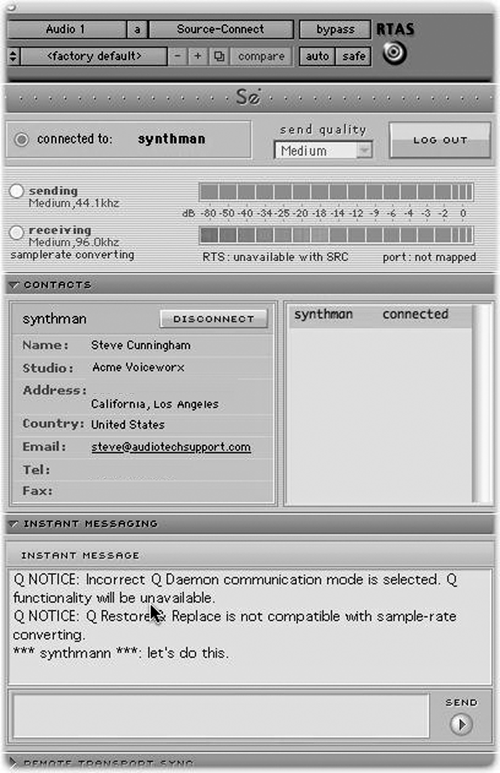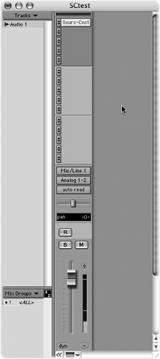
by Steve Cunningham
I’ve had ISDN courtesy of AT&T and Telos for nearly ten years now.
Once I’d paid for the codec (which was about $2000 used, but paid for itself in year one), there was still the monthly phone line charges.
In my neighborhood that’s about $36 every month, or roughly $440 every year. In these times of belt-tightening, it’s hard not to look at that monthly bill and wonder when I can finally pull the plug. These days I do just enough business via ISDN to pay for the line, which is either fortunate or unfortunate, depending on how you look at things.
I continue to look for ways to circumvent the entire ISDN thing, and while there are a few technologies that promise to replace it, nobody has gotten it right so far. I’ve had high hopes for VOIP (voice over internet protocol) boxes like Skype and the so-called MagicJack USB plug for your computer. But while they sound remarkably good when replacing regular phone calls, they still have artifacts and dropouts that make them unsuitable for high-quality remote recording (see the Sidebar).
Source Elements has been creating products to deal with these issues since 2004. Founded by a couple of engineers from the postproduction side of things, their products are finally gaining significant traction for voiceover remotes. The original Source-Connect product was a ProTools-only plug-in that required talent to record into a digital editor. Recently, they’ve release Source Elements Desktop, a version of the program that allows talent to fire up a simple application with a single window, and have their voice recorded in high-quality to a session anywhere else in the world.

MANY FLAVORS OF SOURCE
The Source-Connect plugs come in a Pro version and a Standard version, and Source Elements Desktop program comes with a Standard version of the plug which is fine for small studios and voice talent who may be able to eliminate their ISDN connection altogether for $395. The Pro version plug, which runs $1495 (adding the APT-X option brings it up to $1995), is more suitable for studios with multiple rooms, VPNs, and does run at a higher bit rate. All Source-Connect plugs send and receive audio in AAC format, with the Standard version topping out at 192kpbs for stereo and the Pro version reaching 320kbps.
For studios, the Pro version plug-in is a pricey beast, although the standard version plug is a complete bargain compared to the cost of an ISDN codec. Both versions are available in ProTools RTAS format, VST format, and AU format, all of which means that they will run on a wide variety of digital audio editors. The company also makes a “broadcasting” product called Source-Live, whose primary use is to allow engineers to broadcast a mix to a group of clients and producers simultaneously (no, it’s not a built-in net radio product).
All products require an iLok USB dongle, which is the standard method of copy protection for Source-Connect. You’ll even need one if you just want to evaluate the program -- the demo license is good for 15 days at which point the iLok authorization expires.

GETTING CONNECTED
In order to record remotely, you first need to register yourself as a Source-Connect user or studio on the company’s website. This website acts as a virtual guestbook, keeping track of who you’ve approved and who’s approved you as a partner. When you fire up the Source-Connect software plug, your partners will show in a list allowing you to choose which one you wish to connect to for recording. You’ll also need a broadband Internet connection of some flavor, and Source Elements advise that this needs to have download and upload speeds of at least 300kbps.
If you’re the talent and you’re using the Source Elements Desktop version, it doesn’t get much easier. Source Elements Desktop comes with the VST plug-in, whereby the Desktop program acts as a wrapper to host the VST plug-in. The entire business is very slick and very easy to use, much more so than using the plug as an insert in a digital editor.
Once you’ve downloaded and installed the VST plug and the Desktop application, double-clicking the program activates both. The first thing you’ll see is the Desktop applications main window. You’ll want to configure your audio I/O, which can consist of just about anything you can connect to your computer. This is particularly cool for working on the road, because the app does not discriminate against USB microphones or small USB interfaces from various manufacturers. Just because the main session is on a ProTools HD system doesn’t mean that you can’t use an inexpensive USB headset mic to do the voiceover from several hundred miles away. Clicking on the Source-Connect (or Source-Live) button brings up the actual plug-in. You’ll need access to the plug in order to connect to the remote studio from the list you created earlier on the website, right?
The next section, labeled Record, lets the talent record him or herself during a read. This is an important feature because Source-Connect often fixes glitches that may occur during transmission by replacing chunks of the performance in the background with clean, original audio from the talent’s recording. This is the secret of Source-Connect’s ability to deliver clean audio over the Internet. If the studio is using the Pro version it can, if necessary, actually replace entire tracks in the background after the session recording is done.
The lower half of the Desktop application comes with a mix window where you can adjust the relative levels of your microphone, the playback from the studio, and even a prerecorded file. At the bottom is a talkback function which, if it’s set up properly on the studio end, will make you swear you were in the booth rather than on the other side of the country.
How does it work if you’re engineering in the studio? The Source-Connect plug-in gets installed as an insert on an aux track, then you route the audio to and from that track so that, in effect, the aux track becomes your remote I/O interface. It is important to note that the Source-Connect plug-in does not act like other plug-ins, in that audio routed to the input of this channel no longer reaches its output when Source-Connect is inserted. Instead, audio routed to the input of the channel gets sent out over the Internet, and the audio received from the Internet shows up on the output of the aux track, so it must be bussed to an audio track for recording.
No matter which flavor of the product you’re using, the plug-in portion will provide you with information regarding your send and receive levels, a contact screen that allows you to connect and disconnect from your partner, and an instant message panel that provides real-time information as well as a place to chat with the studio.
 THE SOURCE EXPERIENCE
THE SOURCE EXPERIENCE
Given the fact that most ISDN codecs use some form of compression on their audio, the Source-Connect products sound every bit as good as any Zephyr I’ve heard. In my evaluation of the plugs and the Desktop software, my partner and I did experience a bit of the same fiddley-ness than I’m used to experiencing with ISDN codecs. We did experience the odd dropped connection, but considering that both of us were using dynamic IP addresses I’m not surprised. The company specifically recommends that studios have static IP addresses to eliminate at least the one variable, but unfortunately we didn’t have that option available to us.
As far as I’m concerned, the most exciting thing about the source element products is the fact that I no longer have to counsel new voiceover talent as to whether or not they should purchase an expensive Zephyr codec, or whom at the phone company they might speak to about getting ever more rare ISDN lines installed in their studio.
Have you tried calling the phone company about an ISDN line lately?
The last time I did, a helpful company representative wanted to know why I would want such an old, slow connection for the Internet.
Best of all, Source Elements has reached what I consider to be critical mass in terms of the number of users of their product. There are Source-Connect studios in nearly 70 countries throughout the world, and thousands of voice talents working in and out of their homes are getting their job done using Source-Connect. It’s an idea whose time has come, and it is indeed time to pull the plug on those ISDN lines. Good riddance, and thanks for the extra $36 a month.
For more information worldwide, visit www.sourceelements.com to download a demo or purchase the product.
Sidebar: So Why Doesn’t Plain Old VOIP Work?
As most of you probably know, the Internet works in part because it is based on the theory of packets. All data is broken into packets (sometimes referred to as packetization) before being sent. Each packet carries the sender’s address and the receivers address, along with a serial number. In that way, each packet can take a completely different route to get from the sender to the receiver, and the included addresses and serial number allow the receiver to reassemble the packets into the original message. This concept is key to making Internet communications work, because if the packet is lost along the way the receiver can simply send a message back to the sender requesting that that packet be resent. We are not troubled by the fact that some packets arrive before others, because they’re all going to be reassembled in the end anyway.
Unfortunately this is bad news for high-quality digital audio. High-bitrate digital audio represents a whole lot of packets that must arrive on time and in order. There’s simply not enough time to request a replacement packet without creating a click, pop, or other unwanted noise. So how then do VOIP services like Skype manage to do it? First, Skype’s audio is highly compressed at variable rates, often as low as 32kbps in mono. Second, Skype takes advantage of the two different kinds of packets most often used on the Internet.
The first type of packet is what’s called a TCP packet. This packet contains all of the address information, along with a request for an acknowledgment from the receiver. Simply put, TCP packets ask the receiver to send a message back to the sender saying “yes I got it,” which confirms that a communication channel is open and established but also takes additional time. The second type of packet is called a UDP packet. This packet carries with it no such instruction for an acknowledgment from the sender. It’s simply a packet of data among millions of other packets of data.
So when you call using Skype, the initial conversation consists primarily of TCP packets that establish a channel of communication between you and the other party. Once you start chatting in earnest, the conversation consists mostly of UDP packets that require no acknowledgment. Every now and then Skype will send some TCP packets to ensure that the connection is still valid, but most of your conversation consists of UDP packets. If a few of those UDP packets are lost along the way, no great harm is done and you’ll simply hear a little additional noise or artifacts. These may be annoying, but they’re not a deal breaker when using Skype to call Aunt Tillie. But they will ruin a remote voiceover session.
Will a faster network connection help? Of course it will, but Internet connections seem lately to not be getting faster, but slower as more people connect to the same backbones. Combine that with the issue of Net Neutrality, and for most of us faster pipes are still awhile off.
♦

